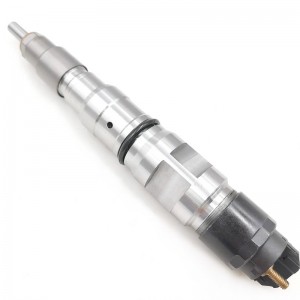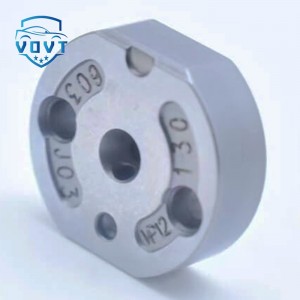New High Quality Diesel Nozzle DLLA162PM011 for Injection Nozzle Diesel Engine Parts
Products Description
| Reference. Codes | DLLA162PM011 |
| Application | / |
| MOQ | 12PCS |
| Certification | ISO9001 |
| Place of Origin | China |
| Packaging | Neutral packing |
| Quality Control | 100% tested before shipment |
| Lead time | 7~15 working days |
| Payment | T/T, L/C, Paypal, Western Union, MoneyGram or as your requirement |
The role of the oil nozzle
Core function: fuel atomization and injection control
1. Atomize fuel into fine oil droplets
Principle: The fuel is sprayed out through the nozzle or needle valve gap under high pressure (diesel engines can reach 100-200MPa, gasoline engines can reach 2-20MPa), and the air resistance and liquid surface tension generated by high-speed flow are broken to form oil mist with a diameter of only 5-50 microns (such as the diameter of diesel engine nozzle atomization particles is about 10-30 microns).
Function:
Increase the contact area between fuel and air (the surface area of 1 liter of fuel after atomization can increase from 0.06㎡ to 100-200㎡), accelerate evaporation and mixing, and improve combustion efficiency.
Avoid unatomized fuel droplets from depositing on the combustion chamber wall, causing carbon deposits, knocking or incomplete combustion.
2. Precisely control the injection direction and range
Structural design:
The nozzle angle and number of the multi-hole nozzle of the diesel engine (usually 4-12 nozzles) are customized according to the shape of the combustion chamber (such as ω-shaped, spherical), ensuring that the oil mist covers the entire combustion space (for example, the nozzle angle of the direct injection diesel engine is radial, matching the piston top pit).
The injection cone angle (about 60°-90°) and range design of the gasoline engine nozzle (such as the electronic injection injector) need to be coordinated with the air flow movement in the intake manifold or cylinder to make the oil mist evenly distributed near the intake valve or spark plug.
Specific role in different engine types
▶ Diesel engine fuel injector: high-pressure atomization and combustion timing matching
Scenario: Diesel engines use "compression ignition" ignition, and the fuel needs to be accurately injected at the end of the compression stroke.
Key role:
High-pressure injection breaks through the resistance of compressed air: Through the fuel pressure of more than 100MPa (such as the common rail system can reach 180MPa), the oil mist penetrates the high-pressure air layer in the center of the combustion chamber to prevent the fuel from gathering on the cylinder wall or the edge of the piston.
Segmented injection controls the combustion rhythm: Some diesel engine injectors support the multi-stage injection mode of "pre-injection-main injection-post-injection" (such as the Bosch CR system). Pre-injection of a small amount of fuel ignites first, reduces the pressure rise rate during the main injection, and reduces nitrogen oxides (NOx) and noise; post-injection can promote post-combustion and reduce particulate matter (PM) emissions.
▶ Gasoline engine injectors: precise metering and mixture uniformity
Scenario: Gasoline engines use "ignition" ignition, and fuel and air need to be mixed into a homogeneous mixture during the intake or compression stroke.
Key functions:
Precise fuel supply under electronic fuel injection control: According to ECU signals (such as speed, load, oxygen sensor feedback), the opening time (pulse width) of the electromagnetic fuel injector is used to accurately control the injection amount (for example, the pulse width is about 1-2ms at idle speed and 8-12ms at full load).
Cooperating with the intake vortex to form a homogeneous mixture: the manifold injection nozzle is usually designed as a "hollow cone" spray form, using the intake air flow to blow away the oil mist to prevent the fuel from depositing on the intake manifold wall; the direct injection nozzle in the cylinder uses high pressure (5-20MPa) and multi-hole design to spray the oil mist near the spark plug during the compression stroke to form a "stratified mixture" and achieve lean combustion (such as Volkswagen FSI technology).
Additional functions: Adapt to engine operating conditions and emission requirements
Anti-clogging and self-cleaning capabilities
The nozzle nozzle has a very small diameter (diesel engine nozzle diameter is about 0.1-0.3mm, gasoline engine about 0.1-0.2mm), which is easily blocked by impurities or colloids in the fuel. Some nozzles use precious metal coatings (such as platinum, iridium) or special nozzle shapes (such as inverted cone holes) to reduce carbon deposits and achieve self-cleaning through the flushing effect of fuel flow (such as the "cleaning injection" function of electronic fuel injection injectors).
Adapt to different fuel characteristics
The injection pressure and nozzle design of the nozzle need to be adjusted accordingly for the viscosity and surface tension of different fuels such as diesel, gasoline, and ethanol gasoline. For example, the viscosity of ethanol gasoline is low, so the nozzle diameter needs to be reduced or the injection pressure needs to be increased to avoid excessive atomization and excessive mixture.
Reduce emissions and noise
Fine atomization can reduce unburned hydrocarbons (HC) and particulate matter emissions; reasonable injection timing can reduce NOx generation (such as delayed injection of diesel engines can reduce combustion temperature); spray morphology optimization can reduce combustion noise (such as pre-injection reduces pressure fluctuations).
Maintenance points: the key to ensuring the function of the nozzle
Use clean fuel: regularly replace the fuel filter (diesel engines are recommended to be replaced every 10,000-20,000 kilometers) to prevent impurities from entering the nozzle.
Regular cleaning: EFI gasoline engines can be ultrasonically cleaned with special equipment (such as injector cleaning machine) to remove carbon deposits in the spray holes; diesel engines need to pay attention to fuel quality, and disassemble the nozzles and soak them in diesel when necessary (do not use gasoline to avoid corrosion of seals).
Professional maintenance: When poor atomization or abnormal injection is found, the injection pressure, atomization shape and sealing performance are tested on the injector test bench (such as the diesel engine injector opening pressure needs to be calibrated to the original factory standard ±5bar). If the wear is serious, the injector parts (such as the diesel engine needle valve-needle valve body parts) need to be replaced.



















